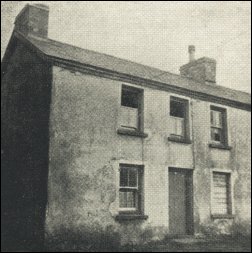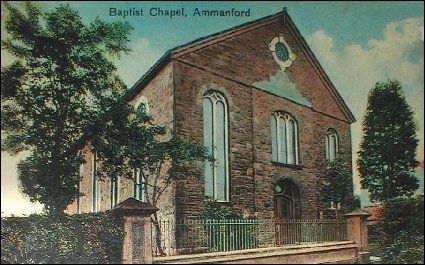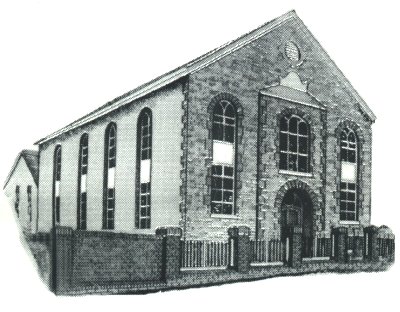The house in Field Street (now Heol Wallasey) in which the first Baptist services were held in Ammanford in 1849. The Baptist Chapel of Ebenezer was founded in 1849, quite a long time after Ammanford's first non-conformist place of worship, Christian Temple, had been built in 1782. There had, though, been Baptists worshipping in neighbouring Llandyfan and Saron before this. As more people became attracted to the Baptist cause they began meeting in Ammanford (or Cross Inn, as it was still then called) at the house of one David Rees of Heol Post (Post Street), later to be known as Field Street, and in the 1950s renamed once more to Heol Wallasey.
In 1849, 15 members attending an assembly decided the time had arrived to build a church. The first baptism rite of three members took place in the river Amman shortly after Christmas, the rite being conducted by a Mr Spencer of Llanelli. The event apparently was received with some antagonism from members of the other denominations in the area.
The church was admitted into Gymanfa at Jezreel in 1850 and a church was built soon after. The chapel, measuring just 12 yards by 10 yards, with a small gallery, was built on land next to Primrose Cottage a few yards from Quay Street. It was named Ebenezer, meaning 'stone of help' in Hebrew, after a stone raised by the prophet Samuel in memory of the defeat of the Philistines (1 Samuel, 7: 11-12). In choosing this name presumably those elders of 1850 saw the raising of their chapel as a victory over Ammanford's Philistines, even at such a late date.
And the men of Israel went out of Mizpeh, and pursued the Philistines, and smote them, until they came under Bethcar. Then Samuel took a stone, and set it between Mizpeh and Shen, and called the name of it Ebenezer, saying, hitherto hath the LORD helped us. (1 Samuel, 7: 11-12)
With the growth in both the local population and the popularity of Welsh Baptism the building had to be completely rebuilt and enlarged to its present size in 1877.
Primrose Cottage was subsequently bought by the chapel and for quite a time was the accommodation for their resident caretaker. By the time of the 1894 register of electors it had acquired the name of Baptist Cottage with the lane on which both chapel and cottage stood acquiring the name of Baptist Lane. The cottage was demolished in the 1960s to make way for a car park for the worshippers.
A smaller chapel, named Capel Seion, was opened for the Welsh Baptist worshippers of Tirydail in 1913 on Llandybie Road. It was not quite the imposing stone structure with balcony and under-floor baptistery that Capel Ebenezer was. A timber frame covered with corrugated iron sheeting led to its almost immediate nickname of Zion Zinc, the name universally used throughout its use as chapel, Sunday school, Infant's school and polling station. With the later decline in attendance, it was eventually sold off by the chapel authorities and demolished in 1993 to make way for a private residence. By now the cypress trees planted around Zion Zinc had grown quite tall, creating rather an antique air about the chapel not quite matched by the corrugated iron walls and roof of the building. The Sunday school teacher for a while was one Christmas Evans, his name a relic of days gone by when people could quite unselfconsciously give children names of biblical figures, events or festivals.
Other Baptist chapels built in Ammanford were: Bethel, Pantyffynnon in 1904; Pisgah, Penybanc in 1912. An English Baptist Chapel had already been established in Watcyn Wyn's old school in Brynmawr Lane, Ammanford, in 1904. This was, and still is, for the worship of English speaking Baptists.
Ebenezer's best known minister was 'Llwyd', the Reverend F. Llwyd Williams (1907 - 1960), who was also a well known poet, winning both the Chair and Crown prizes at the National Eisteddfod: here is a summary of his life and career.
'LLWYD' – THE REVEREND F. LLWYD WILLIAMS
(1907 - 1960)Llwyd was one of several poet-preachers from Ammanford – a breed of people that seems to have disappeared with the decline of the Welsh language and its guardian for so long, religion. He was the youngest of ten children born In Clunderwen on the Carmarthenshire-Pembrokeshire border.
After completing his training at Bangor Baptist College he became a minister, first in Maesteg and from 1936 at Ebenezer Baptist Chapel, Ammanford.
His talents as a Welsh poet were rewarded with the highest accolade that can be conferred on bards writing in our native tongue, not once, but twice: first with the Chair Prize at the 1953 National Eisteddfod held at Rhyl where he used the bardic name of "Ishmael". The next year he won the Crown Prize at the Ystradgynlais Eisteddfod of 1954, this time using the bardic name of "Awelog". He joins that rare band of poets who have won both the Chair and Crown prizes.
The Chair prize is awarded to the best entry of a poem using the traditional 24 cynghanedd metres. The prize is always a chair commissioned from a prominent sculptor of the day. The Crown prize is awarded to the best poem using free metres and consists of a crown, also commissioned from a leading designer.
On returning from the Ystradgynlais Eisteddfod he was met by large crowd on the outskirts of the town who carried him on their shoulders into Ammanford. Banners proclaiming "Croeso i Llwyd" (Welcome to Llwyd) were placed across the road and the procession was led into town by the Ammanford Silver band playing Handel's "See the Conquering Hero Comes". After congratulatory speeches, a spontaneous Gymanfa Ganu (Festival of Song) was taken up by the gathered throng.
Not bad for a mere poet. By today's standards only a successful sports star would get such treatment. The last time in fact that such a welcome was given to a local hero was in 1971 when Cwmgors born Gareth Edwards returned home from the triumphant British Lions rugby tour of New Zealand. This had been the first time that the British Lions had defeated New Zealand in a Test series. When Gareth Edwards got off the train at Neath, he was greeted, not just by his family and friends, but by the entire village who drove him in a motorcade the ten miles up the valley to a welcoming reception at the local rugby club.
Llwyd published several books of poetry and was also a hymn writer of substance. He died suddenly in 1960 aged 53. In 1973 a road in the new housing estate added to Myddynfych was named in his memory – Heol Llwyd (Llwyd, or Grey, Road). Coincidentally the name of his Chair winning poem in the Rhyl National Eisteddfod in 1953 was "Y Ffordd – the Road".
When Amman Valley Grammar School became a comprehensive in 1970, one of the school houses was called 'Llwyd' in his memory. (The other houses in the new comprehensive school were also named after local poets, namely Watcyn, Amanwy and Nantlais. The houses in the former Grammar School had been named after the Welsh princes – and warriors – Hywel, Glyndwr, Llewelyn and Dewi. An improvement in whom we should regard as role models, perhaps).



